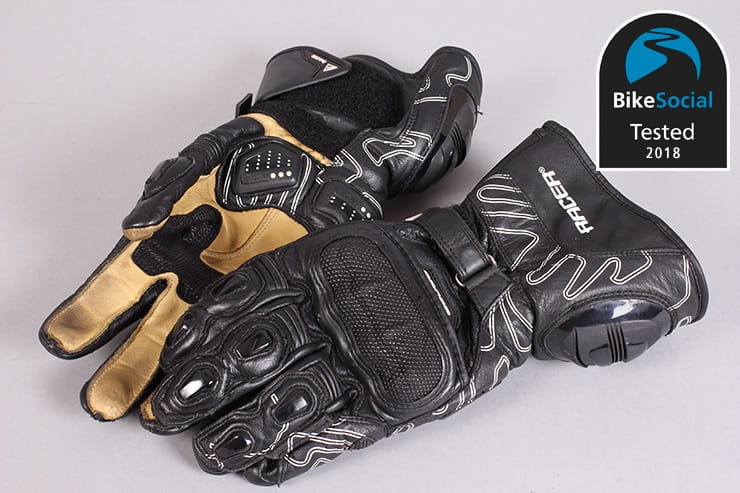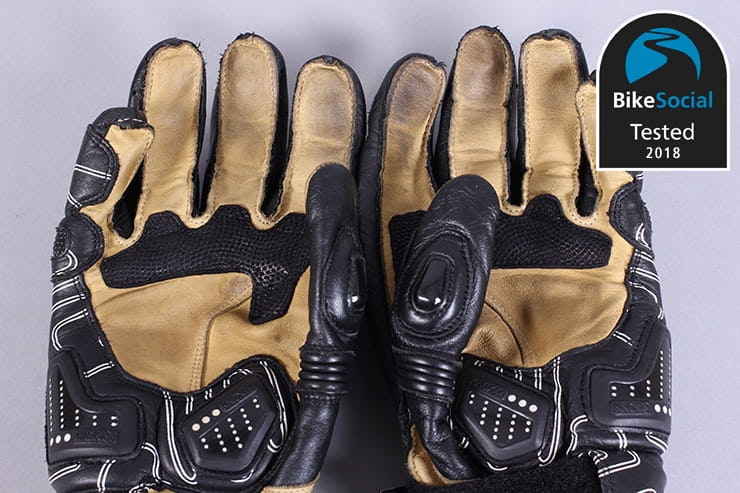Tested: Racer High Speed motorcycle glove review
By John Milbank
Consumer Editor of Bennetts BikeSocial
09.02.2018
Date reviewed: February 2018 | Tested by: John Milbank | Price: £189.99 | www.tranam.co.uk
I’ve used these CE-approved gloves for the last six months on a variety of bikes on road and track, in the UK and Spain. Made of Pittards leather, with a kangaroo palm and Knox scaphoid protection…
Fit and feel
Of course, you should always try any motorcycle kit on for yourself, but I found the Racer gloves to be an excellent fit. The fingers are consistently snug without being too tight, and each is a perfect length.
Stretch panels on the thumb and all bar the little finger work very well, preventing the tips of the fingers getting tight, while the knuckle armour flexes effectively.
The kangaroo palm gives great feel, and none of the protection or armour interferes with your grip on the bars.
Temperature
These are summer gloves, with holes along the inside edges of each finger and a vent on the back of the hand giving good air flow, and keeping your hands cool.
Protection & fastening
The Racer’s wrist strap is extremely effective, keeping the glove firmly in place. The strap is slightly thicker at the end, so it doesn’t slip out of the buckle when you put them on – something that’s very frustrating on some other gloves.
Knox scaphoid protection is fitted to the palm, which helps prevent your hand grabbing on the tarmac in a crash and potentially snapping the large carpal bone beneath your thumb.
The Racers have exposed stitching on the underside of the fingers – while this makes for a more comfortable design and is used in many other gloves, it’s possible that it could be more susceptible to opening up under certain circumstances in a crash. The Knox Handroids that are a direct competitor use concealed stitching, which should be slightly better protected, though at the expense of a seam inside the finger.
I asked motorcycle clothing safety expert and personal protective equipment advisor Paul Varnsverry what the implications of the two designs are: “Gloves bursting open under stress, in the test lab, or on the road has everything to do with the material and thread strength (and both being in balance), rather than whether the construction is concealed or exposed. And then there are the combined, sequential events of what happens in a real accident!
“Unlike CE testing standard EN 13595 for garments, EN 13594 for gloves does not require exposed top-stitching in the highest risk areas to be cut (to replicate being abraded by contact with the road surface) prior to seam strength testing, but it might be argued that the fingertips and all edges inboard of the inside/outside edges of the hand are less likely to sustain the level of contact that could make bursting open after abrasion an issue.
“Externalised seams offer more immediate wearer comfort compared to internalised seams, but the latter have the edge in terms of real-world protection. Riders who want that extra edge will need to spend a little longer wearing their gloves in.”
Wet weather use
Designed as road and track summer gloves, there’s no waterproofing on the Racers. If you do get caught in a storm – as with any leather garments – do not dry them on a radiator. For more advice on bike kit care, click here.
Lining
The polyester lining, which covers all of the top and the cuff of the inside is comfortable, soft, and doesn’t encourage sweating.
Conclusion
I’d not come across Racer until I tried these gloves, but having used them, I now understand why so many other motorcycle journalists rate them highly – they’re an excellent fit and very well made, showing no real signs of wear after several months of use.
These are premium gloves at a top-end price, but they have the build and finish you’d expect – a great choice.
Did you know?
Kangaroo hide is typically tougher than the same thickness of cow hide, but it depends on the quality of the tanning that turns it from skin to leather. For more information on the types of leather available, click here.

